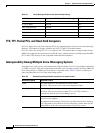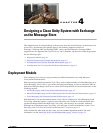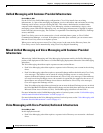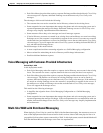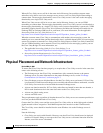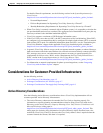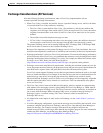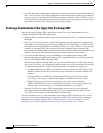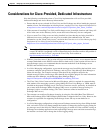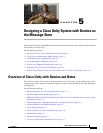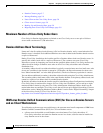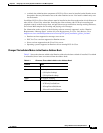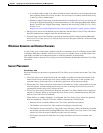
4-8
Design Guide for Cisco Unity Release 5.x
OL-14619-01
Chapter 4 Designing a Cisco Unity System with Exchange as the Message Store
Considerations for Customer-Provided Infrastructure
• In a Voice Messaging configuration, to help prevent Exchange transaction logs from filling the hard
disk, a wizard in Cisco
Unity Setup prompts the installer to change the circular-logging setting for
any message store in the forest for which circular logging is turned off. If the customer is using an
Exchange-aware backup application to back up Exchange message stores and clear transaction logs,
the installer can choose not to change the circular-logging setting.
Exchange Considerations That Apply Only Exchange 2007
Note the following Exchange 2007 considerations when a Cisco Unity implementation will use
customer-provided Exchange 2007 infrastructure:
• Exchange 2007 is supported as the message store only when Cisco Unity is configured as Unified
Messaging.
• The Cisco Unity Voice Connector for Microsoft Exchange, which is required for communicating
with another voice-messaging system by using AMIS, the Cisco
Unity Bridge, or VPIM, can only
be installed on an Exchange
2000 or an Exchange 2003 server. A Voice Connector is not currently
available for Exchange
2007. If the customer has already configured a pure Exchange 2007
environment, an Exchange
2000 or Exchange 2003 server cannot be added to the environment and,
therefore, Cisco
Unity functionality that requires the Voice Connector is not available.
• Cisco Unity Mobile Message Access for BlackBerry is not supported for Exchange 2007.
• Integrated messaging via IMAP with Exchange 2007 is supported when Cisco Unity voice messages
are stored in Exchange 2000 or Exchange 2003.
With Exchange 2000 or Exchange 2003, you can store e-mail messages in one Exchange message
store, store Cisco
Unity voice messages in another message store, and view both types of messages
in a Microsoft Outlook Inbox. In this configuration, known as integrated messaging, you:
–
Configure Outlook to use MAPI to communicate with the message store that contains e-mail
(MAPI is required because the e-mail message store commonly also contains calendars and
contacts).
–
Configure Outlook to use IMAP to communicate with the message store that contains
Cisco
Unity voice messages. (Outlook only supports one MAPI connection at a time.)
–
Enable Exchange rich-text format on Exchange servers, which converts IMAP to
TNEF-encoded IMAP. (If you do not enable rich-text format, voice messages appear in the
Outlook Inbox as e-mail messages, so ViewMail for Outlook is not available.)
Exchange 2007 does not support TNEF-encoded IMAP, but you can still use an integrated
messaging configuration with Exchange 2007 if you store e-mail in Exchange 2007 and store
Cisco
Unity voice messages in Exchange 2000 or Exchange 2003.
For more information on Cisco Unity limitations when Exchange 2007 is the message store, see the
subsection “Cisco
Unity with Exchange: Exchange Server 2007” in the section “New and Changed
Requirements and Support—Release 5.0(1)” in Release Notes for Cisco
Unity Release 5.0(1) at
http://www.cisco.com/en/US/products/sw/voicesw/ps2237/prod_release_notes_list.html.



